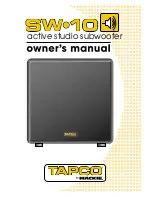
Impression Series Subwoofer
4
Owner’s Manual
Room Setup Suggestions
In order to obtain the best possible sound from your speaker system, it is important to
determine where the speakers will sound best in your listening room. Room reflections
from the floor, ceiling and side walls influence the balance, imaging and overall sonic
quality at the listening position. It is good practice to experiment with speaker placement
to determine which location offers the best overall sound. As a general guide, use the
room layout diagram and the following descriptions when setting up a 5.1 home theater
system. Some speakers shown in the diagram may not always be applicable to your system.
For more home theater system diagrams, please visit http://www.dolby.com.
Front Main Speakers
As a starting point, place your left and right front speakers at least 15 inches away from the
front wall and at least 7-feet apart from each other. The distance from the listening position to
each speaker should be close to the distance that separates the left and right front speakers.
Slightly angling the speakers inward towards the listening position (toe-in) may give a more
spacious and realistic sound stage.
Center Channel Speaker
The center channel speaker should be placed in the center between both left and right front
speakers. Often, this positioning dictates placing the speaker either directly above or below a
television monitor or projection screen.
Rear Surround Speakers
The rear surround speakers may be placed either above, behind, or to the sides of the listening
position. The listening position should be centered between the surround speakers. To obtain
the best performance, experiment with angling the surround speakers either towards, or away
from, the listening position. If using bi-polar surround speakers, the optimal location for these
is about 5-6 feet high on the walls and directly to the left and right of the listening position.
This position should allow one half of the speaker to point forward of the listening position,
while the other half of the speaker points behind the listening position.
Subwoofer
In order to obtain the best possible performance from your subwoofer, it is important to
determine where the subwoofer will sound best in your listening room. Sound reflections from
the floor, ceiling and side walls largely influence the balance, imaging and overall sonic quality
at the listening position. Be sure to experiment with subwoofer placement to determine which
location offers the best overall performance.
Placement of the subwoofer will largely determine quality, quantity and extension of the
bass frequencies within your listening room. Bass frequencies are reinforced by close room
boundaries. Thus, placing the subwoofer closer to a corner will make the subwoofer sound
louder and boost the very lowest frequencies.
Placing the subwoofer away from walls will provide the least reinforcement, making the bass
sound subjectively thinner than if the subwoofer were closer to a wall. Good results can usually
be obtained by placing a subwoofer along a wall and approximately 1-3 feet from a corner.
Experiment with placement of the subwoofer and adjust the amplifier controls and your surround
processor’s bass management settings to achieve the best bass balance.
































